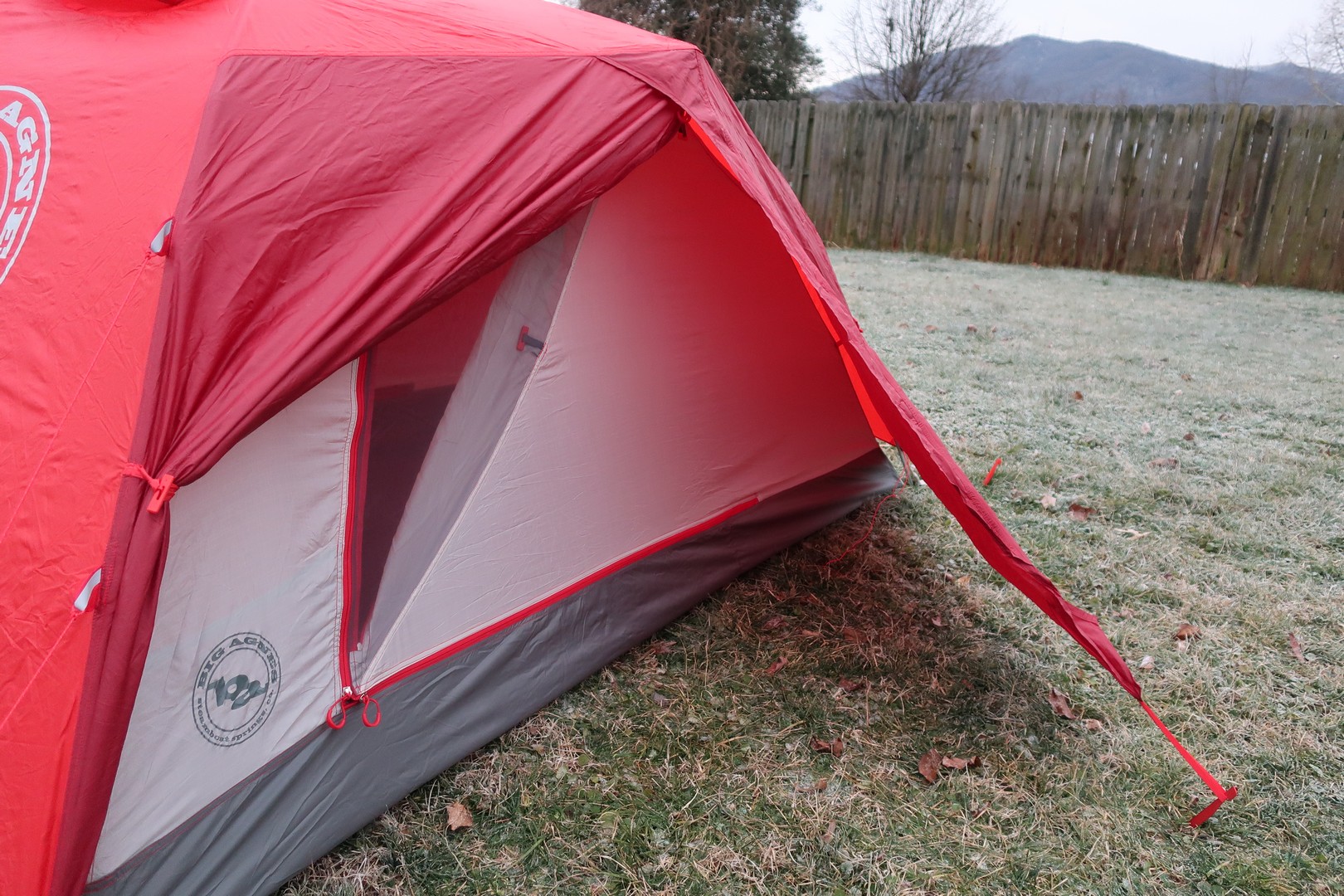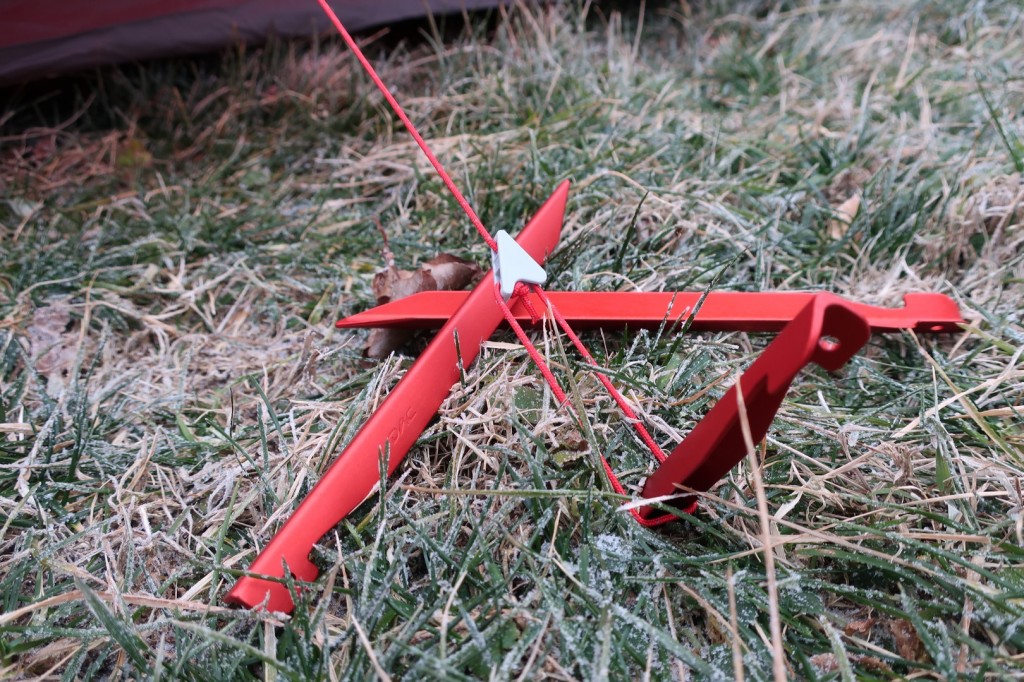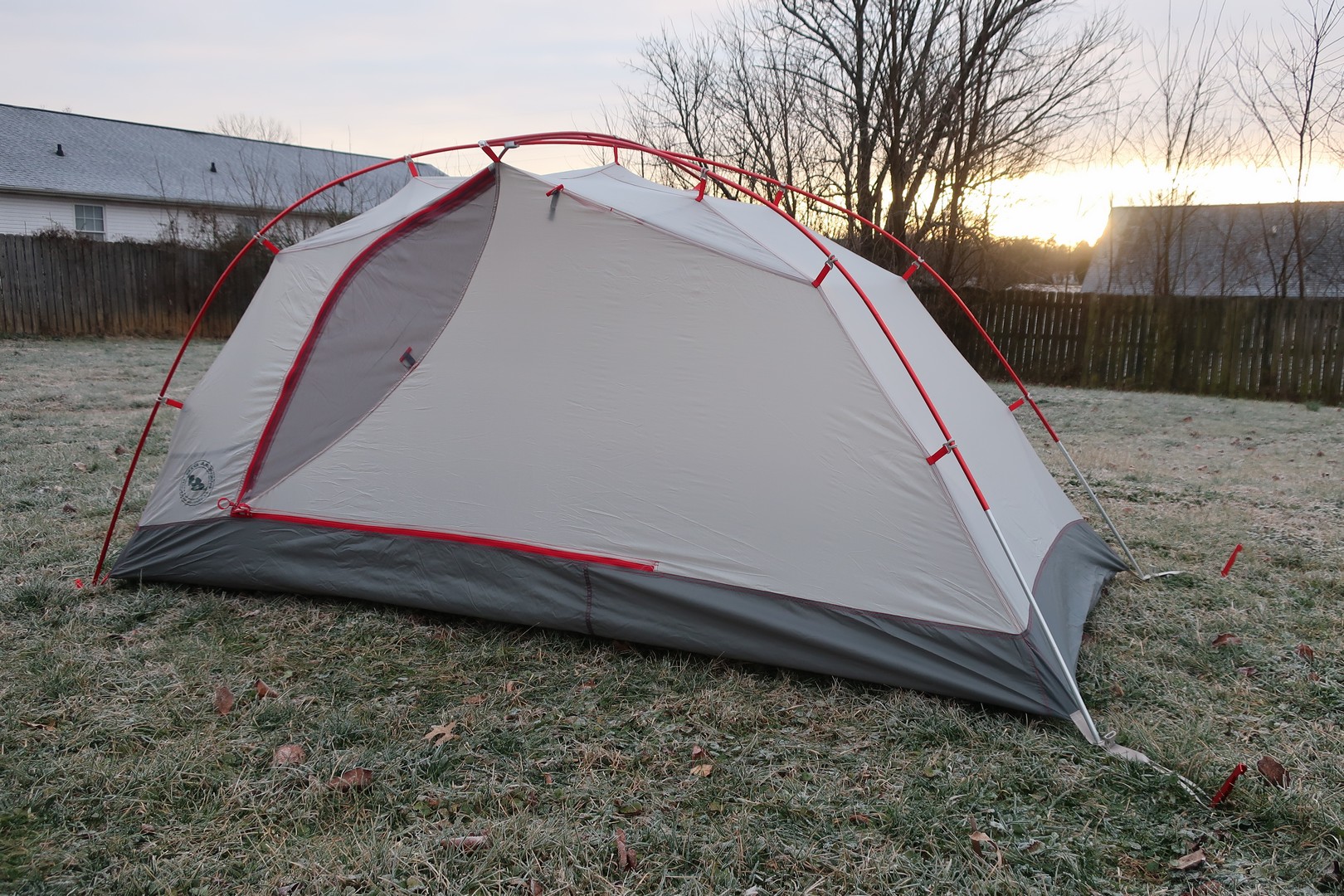The Copper Spur Expedition bridges the gap between ultralight 3-season tents and burly 4-season expedition shelters, offering something that is both lightweight and rugged for when the weather goes south but the trail goes up.
Based on the longstanding and excellently designed ultralight Copper Spur series, the Expedition variation maintains the basic design, but makes some major structural changes. There are still two double-zippered doors, two vestibules, a top vent, and a very similar 4 pole, high volume hubbed frame. That, however, is basically where the similarities end. Instead of floaty, thin nylon and breezy mesh fabrics, the Expedition uses a more rugged rip-stop nylon with randomized internal fibers, a breathable polyester body, thicker 9.6 mm DAC Featherlight NSL aluminum poles, and oversized aluminum J-stakes designed for frozen dirt and snow alike. The interior has three zipper sealable vents, one on each door and one at the peak, and a total of 12 interior pockets. There are also numerous attachment points for accessories. The tent dimensions come in at 88″, x 52″(head)/42″(foot) with a peak height of 39″. The tent packs up at 7″ x 20″, weighs 5′ 8 oz, and retails for $499.95.

What I liked
The first thing that stands out with the Expedition 2 to me is the build quality. Unlike the whimsy 3-season shelters it visually compares to, this shelter is designed to take a beating. The fabrics are relatively thick, tough, generously coated, and robust enough to resist fraying or tearing when stretched and shifted under tension. Each seam is double-stitched and reinforced with polyurethane seam tape, while the entire shelter, bottom and top is entirely coated with 1200 mm polyurethane/silicone coating to waterproof it. The stake out points are built from thick webbing, while the guy-lines themselves are exceptionally durable Dyneema cordage, tacked down with unusually thick aluminum j-stakes. All around, each corner of the tent feels comfortingly durable, robust, and has held up wonderfully so far.
When placed against the elements, the Expedition 2 holds up great. In conditions that traditional 3-season tents would struggle, this one feels at home. This is primarily due to the beefed up 9.6 mm frame set. The oversized poles come in from four corners, meeting at the central hub, with a brow pole that sits over top. This, when combined with the complementing guy line supports and multi-point stake out system (a combined 14 guy/stake points), prevents the tent from swaying too far in any direction. Most tents actually fail when snapping back to shape after wind has deformed them, as the amount of tension and pressure created from this rubberbanding can be rather extreme. So, preventing this folding and flexing in the first place greatly increases the tent’s ability to withstand harsh conditions. I’ve found the shelter able to to avoid buffeting or caving in under 35 MPH winds without issue when properly pitched, and mild snowfall isn’t much of an issue either thanks to the sloping roof and stiffness of the poles. The overall shape of the tent does a good job of shedding the wind to begin with, allowing most breezes and gusts to simply move over or around the tent, instead of crashing into the walls. The result is a shelter that handily outperforms basically anything else I’ve tested in the weight class, bestowing confidence in rough weather.

Livability in the Copper Spur Expedition is rather good. The 88″ length and 52″ shoulders (narrowing to 42″ at the foot), provides plenty of room for two campers to sleep shoulder to shoulder, with a little extra room on each side for sprawling elbows or some equipment. The 42″ peak height doesn’t sound remarkable on paper, but once your inside the tent really opens up. The poles are bent in such a way that it presses the walls upward, increasing volume inside and lifting the ceiling far more than I initially expected. It also helps that there is a wide brow-pole that also pulls out both walls to a near vertical orientation, freeing up shoulder and elbow space. Two average sized campers happily can sit inside without touching the walls or ceiling at all, and tasks such as packing up, changing or scavenging for that missing sock are largely unimpeded. It also helps that the bold colors create a warm, inviting glow inside, even on completely overcast days, boosting morale when a seemingly never-ending storm is blowing through.
Storage capacity is excellent, with a total of 10 interior pockets providing more than enough space for phones, headlamps, reading materials, socks, or pretty much anything else you could want to string up inside. If that isn’t enough, multiple attachment points allow accessory lofts to be attached. The two large vestibules easily accommodate two complete sets of gear, boots and cookware, while still allowing a entry/egress pathway to be completely unobstructed for entry and exit. This eliminates the need to crawl over packs or wet rain gear, and makes getting in and out much easier.
Pitching the shelter is exceptionally easy and rather fast. The entire pole system is corded together and joins at a central hub, snapping together effortlessly with no need to memorize where each pole segment belongs. The pole tips and the connection points of the body and rainfly are each color coded, completely eliminating any guesswork when setting it up. Simply stake out the body, pop in the 4 matching pole tips, lift the clips on the tent body to the frame, pop in the brow pole, and throw over the rainfly. The rainfly attaches via simple clips and tensioners allow the pitch to be dialed in taut every time. There isn’t much of a way to go wrong here. The shelter can be pitched in about 5 minutes while just staking out the 6 essential corners. However, a full pitch utilizing the guy-lines, Velcro inner attachment points and all 10 stakes is high recommended, which will take about 10 minutes total, or 7 minutes with a little practice.
Condensation management if fantastic. The tent includes a large top vent, dual-zippered doors that function as vents (unzip them from the top a bit), large gaps under the rainfly, and three inner body vents that can be completely closed or opened up to trap or release warm air. The inner body is fully breathable, allowing moist air to diffuse out, but also blocks direct wind from access campers inside entirely when the doors and ceiling are zipped up. Gusts can flow under the vestibule, but blow up and over the actual tent body, exhausting hot air while without creating a cold, breezy interior. This makes the shelter feel quite a bit warmer than it actually is, which is nice for winter. When unzipped, the same polyester doors, ceiling, vestibule door vents and top vent all work together to dump pretty much all hot air inside, while still blocking rain and snow. This allows the inside of the tent to stay warm, dry, and well managed by simply moving some zippers back and forth. Even when completely zipped up, I’ve had little condensation build up below freezing. However, in temperatures above 40 F moisture will start to build up, requiring the vents to be opened in humid conditions. The tent will get a bit warm when used in temperatures above 70 F.
Considering the durability, I found the weight of the Expedition HV 2 to be exceptional. Often, I come across tents with similar specs that simply cave in under the force of high winds, while still providing little internal volume, or simply devoid of helpful features like second doors and vents. Instead, this shelter sports more durable materials, 6 vents in total, 10 pockets, and still manages to be spacious while only weighing a bit over 5 pounds. This is far from ultra-light territory, but considering the capabilities and full feature set of the shelter, I’m rather impressed.
I really love the huge 8″ aluminum J-stakes. The are easy to pound into basically any soil, frozen or not, and provide excellent holding power.

What I didn’t like
While robust and incredibly versatile, the Copper Spur HV 2 Expedition still isn’t a true 4-season tent. While I trust it above 6,000, 10,000 or even 14,000 feet, I wouldn’t consider this tent for somewhere where huge snow dumps or extreme wind will be present. For that, a true 4-season shelter will still be a smart purchase. Although, this will likely survive if those conditions do show up unannounced.
The tent comes in two stakes shy of being able to be completely guyed out from all sides. There is plenty for staking out the tent and guying out the shelter facing an incoming storm, but without the final two stakes the opposite end of the shelter will be absent of guy-line support. If the wind shifts, I either have to get out and move the included stakes to face the wind, or add two more to my kit. So far I’ve been unable to find matching stakes to finish the set.
The guy lines and triangular attachment style gets tangled up easily while being packed, so take care to avoid wrapping all the cords together when stuffing it away. Untangling them in the rain or wind isn’t a fun time.
I wouldn’t take this shelter out for a hot summer trip as it could turn into a sauna, despite the excellent ventilation.

Overall
The Copper Spur HV 2 Expedition happily hangs out in areas that traditional 3-season tents would absolutely struggle, or even fail. The frame is robust, the guy-points generous, fabrics tenacious, and the overall build quality is undoubtedly fantastic. The combination of smart design and high quality materials allows the shelter to outperform basically anything in the weight class. It’s strong enough for most winter camping excursions, vents well enough for Spring and Fall trips, and holds up well enough for high elevation epics. Given the exceptional flexibility of the design and the fact that is still manages to be a fully featured, spacious, shelter at under 6 pounds, I cannot recommend this shelter enough to anyone who emphasizes pack weight and durability. For those who refuse to let the quality of their shelter dictate where or when they camp, this is an excellent solution.
The highest of Recommendations
For more information on Big Agnes and their gear, check them out here. You can also check out this product and support our site by using our Amazon Affiliate Link Here. This helps us out too.
For information on our rating system and our testing procedures, check out our About us/ Contact us page.
I want to extend a huge thanks to Big Agnes for providing this product for review. We couldn’t do it without their help.
Our full disclosure can be found here. Thanks as always for reading! Don’t forget to follow our blog for future updates and reviews.
If you have any questions, comment below, send us an email, or find us on Twitter or Facebook (links on the right)









Thank you for the very valuable feedback. : )
I’m happy to provide. Thanks for reading!
Excellent review! Very detailed with a lot of information.
Thank you for taking the time to write such a good review.
Thanks! I never really know how long these things are going to be when I start writing, so hopefully it isn’t too long (I honestly left out about half of what I could say, but I try to concentrate on the big points). Thanks for continuing to follow the blog. It is much appreciated.
Excellent trnt for northern BC weather conditions
Oh I bet it is! Where i’m at, it’s just hot, back to back thunderstorms and humid. Not exactly my favorite combination. 😛